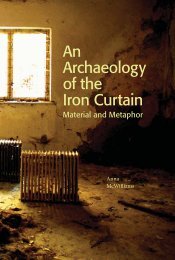Create successful ePaper yourself
Turn your PDF publications into a flip-book with our unique Google optimized e-Paper software.
58<br />
A RAJA ENJOYS A HUQQA DURING A COLD WINTER NIGHT<br />
PAHARI SCHOOL, NORTH <strong>INDIA</strong>, CIRCA 1825-50<br />
Opaque pigments heightened with gold on paper, the palace interior with a<br />
European-style fre place in which burns a lively fre, a European style foral<br />
carpet is laid on the foor, the Raja lies on a daybed, covered with a blanket<br />
decorated with large fowers, a female attendant changes the coal and<br />
tobacco of his huqqa, within black and white rules and red borders, mounted,<br />
framed and glazed<br />
9Ω x 5æin. (24.2 x 14.6cm.)<br />
£6,000-8,000 $8,600-11,000<br />
€7,500-10,000<br />
PROVENANCE:<br />
Acquired from Colnaghi, London, 5 June 1979<br />
The subject of this painting, a Raja wrapped up tightly against the cold, is an<br />
unusually intimate one for Indian painting. Other portraits of fgures clothed<br />
in large blankets include a depiction of Bhup Singh with his Rani wrapped up<br />
in the same quilt and attributed to Guler, circa 1795-1800, now in the Victoria<br />
and Albert Museum (I.S. 202-1949; Visakha N. Desai (ed.), Life at Court:<br />
Art for India’s Rulers, 16th-19th Centuries, Boston, 1985, no.75). A painting<br />
attributed to Nainsukh, circa 1760 shows Balwant Singh in a tent at Nagrota,<br />
similarly clothed and smoking a hookah in a manner similar to our portrait<br />
(Kalpana Desai and Pratapaditya Pal, A Centennial Bouquet, Mumbai, no.84).<br />
59<br />
AN ILLUSTRATED FOLIO FROM A GAJA SALOTE (ELEPHANT<br />
ALMANAC): THE ELEPHANT SALHAI<br />
JAIPUR, RAJASTHAN, NORTH <strong>INDIA</strong>, VS 1881/1824 AD<br />
From an almanac, opaque pigments on paper, the elephant carrying his<br />
mahout, harnessed and carrying a howdah, his head painted and bejewelled,<br />
on blue background, within yellow, red and black rules, inscription in black<br />
devanagari script at top, mounted, framed and glazed<br />
The painting 7æ x 5Ωin. (19.7 x 14cm.) ; page 9º x 7Ωin. (23.5 x 19cm.)<br />
£2,000-3,000 $2,900-4,300<br />
€2,500-3,700<br />
PROVENANCE:<br />
Acquired from Colnaghi, London, 5 June 1979<br />
The Gaja Salote (elephant almanac) is a manuscript that describes elephants<br />
from diferent parts of the country, their qualities, diseases and treatments.<br />
Another folio, depicting Gaindmala, an elephant from the eastern province<br />
of Assam is in the Cincinnati Art Museum (Ellen S. Smart and Daniel S.<br />
Walker, Pride of the Princes: Indian Art of the Mughal Era in the Cincinnati Art<br />
Museum, Cincinnati, 1985, cat. 38). According to the manuscript’s colophon,<br />
it was written by Shyam Vaid and completed in VS 1881/1824 AD. The<br />
patron might have been Rao Asi Singhji of Mukhtapur. Other pages were<br />
sold at Christie’s, London, 11 and 12 June 1984, lot 61 and 4 July 1985, lot 9.<br />
38




